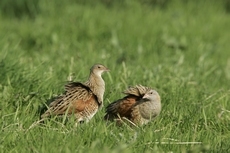A rare breeding bird concentrated in the Highlands has surprised experts by enjoying its most successful season since records began.
The national population of corncrakes has reached its highest level in at least 45 years, according to an annual RSPB Scotland survey.
A total of 1,289 calling males were recorded in Scotland between May and July this year, baffling experts who had predicted corncrake numbers would fall after the species suffered an alarming decline of 23% in 2013.
Corncrakes are shy, pigeon-sized birds which breed in Scotland and migrate to Africa in winter.
They mainly stay hidden among tall vegetation where they can safely raise a family, and are much more often found by hearing their distinctive rasping ‘crex-crex’ call, rather than actually being spotted.
The birds were once common across the farmed landscape in Scotland. However, they suffered huge declines throughout the 20th century when agricultural production intensified and farmers started mowing their hay meadows and silage fields earlier.
By the early 1990s, the population had dwindled to a mere 400 singing males, highly concentrated in the Inner Hebrides, Western Isles and Orkney.
But in 1991, a cooperative conservation programme began to improve corncrake populations in Scotland.
Supported by RSPB Scotland, Scottish Natural Heritage and the Scottish Government, farmers and crofters have played a key role by leaving grass fields uncut or un-grazed until August, and using mowing operations which favour the birds’ survival.
Corncrake populations immediately stopped declining and began to recover in response to this programme.
This year’s biggest single island population is on the isle of Tiree – a location holding 396 calling males.
Paul Walton, head of Habitat and Species for RSPB Scotland, said: “This year’s figures for Scottish corncrakes are fantastic. They are testament to the dedication of crofters, farmers, the conservationists working alongside them, and to the Scottish Government and SNH officials who have helped target agricultural support to deliver this result for wildlife.
“However, last year’s fall in corncrake numbers was worrying and this bird remains highly vulnerable, so we can’t afford to be complacent. Even though there has been an increase in numbers this year, we have so far failed to expand the corncrake’s breeding range. They are still found in only a few isolated areas of Scotland, mainly on the islands, so that’s where we need to focus our efforts next.”
